The AMD Trinity Review (A10-4600M): A New Hope
by Jarred Walton on May 15, 2012 12:00 AM ESTAMD Trinity: Battery Life Also Improved
With all of the changes going into Trinity, one thing that hasn’t changed since Llano is the process technology. Trinity is once again coming on a 32nm process from GlobalFoundries. If we were talking about Intel, Trinity would represent a “Tock” on the roadmap—a new architecture on an existing process. We’ve looked at CPU and GPU performance, and this is a part that’s pretty much universally faster than its predecessor. Given the lengthier pipeline and Bulldozer-derived architecture, I admit that I was concerned Trinity might actually be a step back for battery life; it appears that my fears were unfounded, largely due to the improvements in Piledriver. As usual, we tested with all laptops set to 100 nits brightness in our idle, Internet, and H.264 playback tests. I also ran some additional tests which we’ll discuss in a moment. First, here are the standard battery life results:
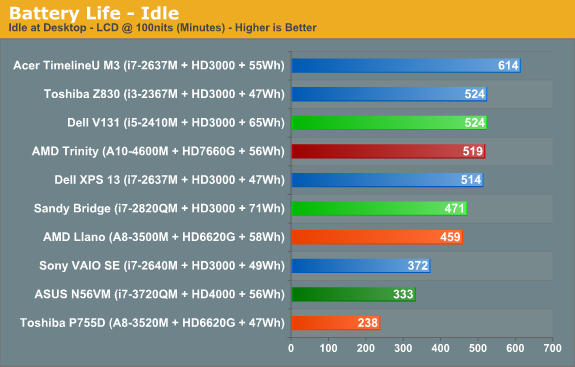
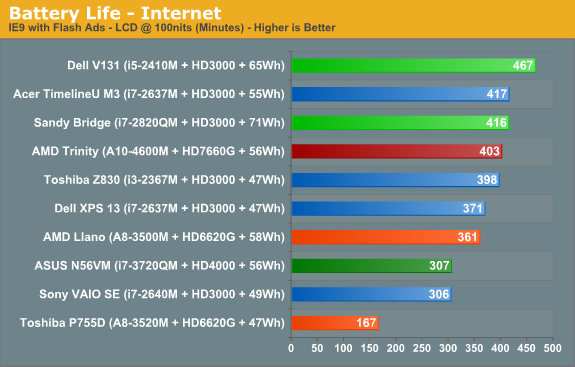
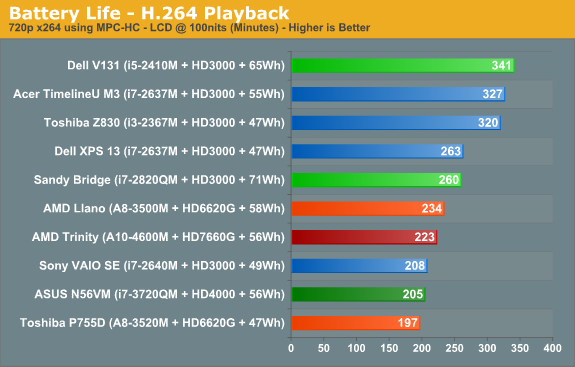
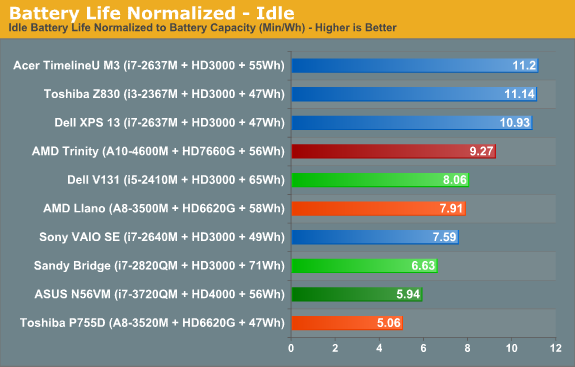

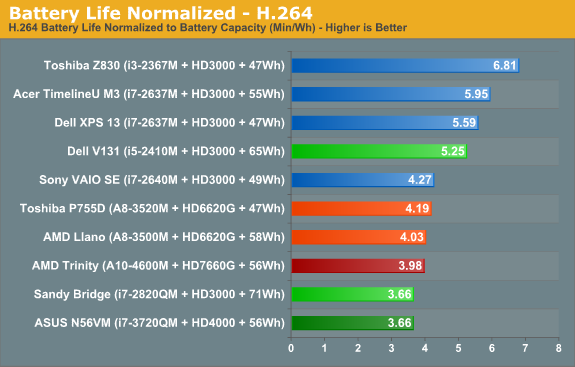
With a similar capacity battery to the original Llano laptop, and the same size 14” panel, Trinity comes out of the gates and posts two clear wins: idle battery life and Internet battery life are both up substantially relative to Llano. In fact, looking at the normalized charts, the only laptops that can consistently beat Trinity are found in Sandy Bridge ultrabooks—we won’t even bother discussing Atom or Brazos netbooks, as they’re competing in a completely different performance bracket. In something of a surprise, H.264 battery life doesn’t see the same benefit unfortunately, and it’s the one discipline where Llano still holds on to a slight lead over Trinity. Sandy Bridge meanwhile has always done very well in H.264 battery tests, and we see that with the Vostro V131 posting a normalized score that’s 30% better than Trinity and Llano. Of course, on the other end of the spectrum we have Ivy Bridge; we’ve only looked at one Ivy Bridge laptop so far, but if the pattern holds than Ivy Bridge will generally be a moderate step back in battery life relative to Sandy Bridge, giving AMD an even larger lead in this area.
We also performed a few other tests that we won’t present in graph form. One set of tests we alluded to earlier: the charts show Trinity with a Samsung 830 SSD, but we also ran tests with an Intel 520 SSD. Idle battery life dropped to 476 minutes (an 8% decrease), Internet battery life checked in at 371 minutes (down 8% again), and H.264 battery life stayed nearly the same at 217 minutes (down less than 3%). If battery life is one of your primary concerns, remember: all SSDs are not created equal!
Another test that we ran is simulated gaming; we looped the four graphics tests in 3DMark06 at 1366x768 until the battery ran out. We’ve run this same test on quite a few other laptops, and Llano initially looked to be far and away the best solution. Later, we discovered that when we tested Llano we were letting the GPU run in power saving mode—basically half the performance you’d get compared to being plugged in. We retested and measured 98 minutes, so the extra graphics performance comes with a heavy cost. We only tested Trinity (and Ivy Bridge and Sandy Bridge) using higher performance graphics settings, and this is one more area where it scores worse than Llano: Trinity managed just 77 minutes. That’s about the same as Ivy Bridge and Sandy Bridge (79 and 73 minutes, respectively), so if you’re after better gaming performance while running off the mains, you might need to keep looking.
Before getting too carried away with the above results, you still need to consider how important battery life is for your usage model. Some people travel a lot and like to go all day without plugging in; others will go from place to place and plug in whenever they’re not on the go. If you fall in the latter category, battery life isn’t usually a problem with any decent laptop, while those looking for all-day computing will definitely want as much mobility as possible. Ultimately, battery life is a factor of battery capacity as well as power optimizations done by the OEMs. We’ve seen battery life improve by as much as 50% when comparing two otherwise similar notebooks, but at least AMD’s reference platform for Trinity delivers a great starting point.
Temperatures and Acoustics
One other item we wanted to quickly touch on is system temperatures. We typically use HWMonitor and check temperatures of laptops under idle and load conditions. We did this with Trinity as well, but unfortunately the current version of HWMonitor doesn’t give us a lot of information. The only temperatures it reports are from the SSD and the HD 7660G graphics—there’s nothing about CPU core temperatures. That means we can’t provide much detail, other than to say that load temperature on the GPU topped out at 71C during extended testing, while the idle temperature was 39C. As usual, temperatures and noise levels go hand in hand, and the low 71C maximum GPU temperature matches up nicely with noise levels that never got above 37dB. It’s not the quietest laptop we’ve ever tested, and surface temperatures can get a little warm, but overall Trinity looks to be a good balance of performance and power requirements, which means quiet laptops are definitely possible.










271 Comments
View All Comments
medi01 - Friday, May 18, 2012 - link
Somehow one doesn't wonder at tomsharware, that comparing chips with vastly different price is a bad idea.TC2 - Sunday, May 20, 2012 - link
amd cpu is far behind intel cpu! about gpu! nvidia is also far better as performance & software support! so for professionals and buyers with budget there isn't point to go with amd! :)))but for amd - as good as is get :))) sorry
kevmanw430 - Tuesday, May 22, 2012 - link
Jarred, what version of Skyrim was tested? Bit of a question in a forum discussion, would like to know.Thanks!
JarredWalton - Wednesday, May 23, 2012 - link
Running the Steam variant, so it's automatically updated. At time of testing, I believe it was version 1.4 (with high res texture pack). The tested sequence is in the area of Whiterun, as I found in initial playing (on a desktop) that it was one of the more demanding areas. I wanted to find the "worst case" situation for playing the game, so that if you get >30 FPS in our benchmark, you'll generally get >30 FPS throughout the game. There's a reasonable chance that other parts of the game are less CPU intensive and thus might show Trinity in a better light, though it's debatable whether that's more or less meaningful than the current results.seapeople - Tuesday, May 22, 2012 - link
Why do you even read computer reviews then? Every single review I've ever read in my life on any site ever created includes a new, top of the line product in the graph REGARDLESS of what's being reviewed. It's not bias, it's not inattentiveness, it's not even remotely absurd as you state, it's quite simply expected for computer reviews.seapeople - Tuesday, May 22, 2012 - link
This is quite silly. We're not comparing a $90,000 Mercedes to a $16,000 Hyundai, we're comparing a processor that might be in an $800 computer to one that might be in a $600 computer based on how sales are at any particular point in time.It's amazing that two or three negative posters account for roughly 50% of the comments on this thread. Somebody is trying too hard.
Stradi - Friday, May 25, 2012 - link
I'm a bit confused about how this review was done. Are they comparing the APU without the extra discrete GPU against intel Ivy Bridge with discrete GPU from nVIDIA and saying the Ivy Bridge is better for gaming? or is this comparing the APU with AMD's discrete GPU that's on crossfire against intel/nVIDIA setup?I assumed the crossfire setup will actually prevail against ivy bridge/nvidia in terms of gaming. I was waiting for Trinity not because it's got a decent GPU in there, but it gives you the option to crossfire with AMD's discrete GPU. And while I like the nVIDIA's discrete GPU option, I didn't think it can havest the intel HD 4000 graphics power and add to it.
I need some clarification on this. I hope they didn't mean to compare an AMD's new APU with Intel's latest+nVIDIA's latest. Why would any reviewer think that'd represent a fair comparison? why would they put an extra discrete GPU in one machine and say that's a better gaming machine?
rarson - Tuesday, May 29, 2012 - link
The AMD APU is not paired with a discrete APU.Obviously the review is confusing and full of incongruous comparisons, but Jarred and Anandtech aren't going to fix it.
rarson - Tuesday, May 29, 2012 - link
Anandtech now responds to criticism by simply deleting it. Or was that Jarred's doing?R3MF - Friday, June 1, 2012 - link
the slides say OpenCL 1.1, will full support in hardware for 1.2 arrive?